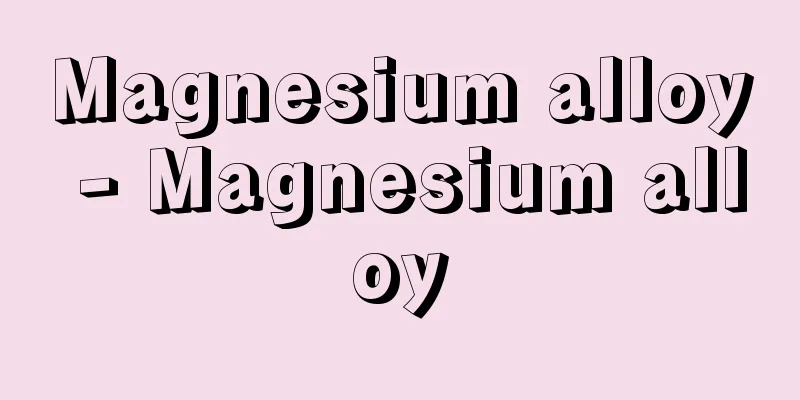Magnesium alloy - Magnesium alloy

|
Magnesium is even lighter than aluminum (specific gravity 1.74), and its alloys were also created with the intention of making lightweight machine parts and structural materials. The first was the Elektron alloy (5-10% aluminum, 0.5-3.5% zinc, with a small amount of manganese) invented by G. Elektron in Germany in 1909. A similar alloy was manufactured in the United States under the name Dowmetal. These alloys are age hardenable like aluminum-based high-strength alloys, and can be used for castings and rolled materials, but they have poor corrosion resistance. A series of zirconium-added alloys developed later, such as the magnesium-zinc-zirconium system, magnesium-zirconium-rare earth elements (mainly cerium) system, and magnesium-zirconium-thorium system, each have their own characteristics in high-temperature strength and castability, but they also have poor corrosion resistance. The magnesium-manganese system (1.2% manganese, 0.09% calcium) has slightly improved corrosion resistance, but is still insufficient. The most widely used alloys today are Ellen alloys with 8.3-9.7% aluminum, 0.35-1.0% zinc, and 0.15% manganese or more, and are used as die-castings for machine parts. The tensile strength at room temperature is about 250 MPa. Ellen alloys are also used as anodes in galvanic protection, a special application that protects steel structural materials in moisture by cathodicizing their electrode potential (→Corrosion of metals). All magnesium alloys have poor corrosion resistance, so the JIS specifies the corrosion protection treatment method in detail. In addition to the above, alloys for nuclear reactor structures that take advantage of magnesium's low thermal neutron absorption have been attracting attention, such as Magnox, which contains 1% aluminum, beryllium, and small amounts of calcium. Magnesium is a hexagonal crystal with poor plastic workability, so research is being conducted on adding lithium (Li) to create a cubic crystal alloy. Source: Encyclopaedia Britannica Concise Encyclopedia About Encyclopaedia Britannica Concise Encyclopedia Information |
|
マグネシウムはアルミニウムよりさらに軽く (比重 1.74) ,その合金も軽量の機械部品,構造材料を意図してつくられた。最初のものは 1909年ドイツの G.エレクトロンの発明したエレクトロン合金 (アルミニウム5~10%,亜鉛 0.5~3.5%,マンガン少量添加の組成) である。類似の合金がアメリカではダウメタルの名で製造された。これらはアルミ系高力合金と同じく時効硬化性があり,鋳物にも圧延材にもなるが,耐食性は悪い。その後開発されたマグネシウム-亜鉛-ジルコニウム系,マグネシウム-ジルコニウム-希土類元素 (おもにセリウム) 系,マグネシウム-ジルコニウム-トリウム系など,一連のジルコニウム添加合金は高温強度や鋳造性にそれぞれ特徴はあるが,耐食性はやはり悪い。マグネシウム-マンガン系 (マンガン 1.2%,カルシウム 0.09%) は耐食性はやや改善されているが不十分である。現在最も多く実用される合金はアルミニウム 8.3~9.7%,亜鉛 0.35~1.0%,マンガン 0.15%以上のエレクトロン系合金で,ダイカスト鋳物として機械部品に用いられる。室温における引張強さは 250MPa程度である。ほかに特殊用途として,湿気中の鉄鋼構造材の極電位を陰極化して防食する流電防食法の陽極にもエレクトロン合金が使われる (→金属の腐食 ) 。マグネシウム合金はすべて耐食性が悪いので,JISではその防食処理法を細かく規定している。以上とは別に,マグネシウムの熱中性子吸収の小さいことを利用する原子炉構造用合金が注目されており,アルミニウム1%,ベリリウム,カルシウムを少量含むマグノックスがある。マグネシウムは六方晶で塑性加工性が悪いので,リチウム Liを加えて立方晶の合金をつくることが研究されている。
出典 ブリタニカ国際大百科事典 小項目事典ブリタニカ国際大百科事典 小項目事典について 情報 |
>>: Magnesium - Magnesium (English spelling)
Recommend
Border Leicester
…The most common varieties are Lincoln (native to...
Saint-Germain-en-Laye (English spelling)
A city in the Yvelines department in northern Fran...
phylum
…The method of naming is regulated by the Interna...
litter-feeder
…Soil animals are one of the life forms. Types of...
Concanavalin A
A type of lectin obtained from jack beans. It is a...
Cellulose - celulose
The main component of plant cell walls. It is the...
Arare soba
...The name first appears in documents from the b...
Han Fei-zi (English spelling)
[raw]? [Died] Shi Huang 14 (233 BCE) A Chinese thi...
Atlantic Ocean
It borders the European and African continents to...
Trease, G. (English spelling) TreaseG
…Adventure novels also developed through J. Masef...
Indicator - characteristic
(1) Usually refers to the integer part of a common...
Virchow
Also known as Virchow. German pathologist and poli...
Memorial Keirin
…The velodrome holds 12 races a year, each lastin...
International Whaling Commission
…The appendix lists specific control measures for...
Gamou Taro
...A samurai family from the Heian to early Edo p...









